ADHD: A Comprehensive Report on Causes, Diagnosis, and Treatment
VerifiedAdded on 2021/04/21
|9
|2693
|60
Report
AI Summary
This report provides a comprehensive overview of Attention Deficit Hyperactivity Disorder (ADHD), encompassing its causes, nature, demographic data, diagnostic criteria, differential diagnosis, treatment approaches, and cultural considerations. The report is based on information gathered through an interview with Dr. Paul Cline and explores the environmental, genetic, and psychological factors contributing to ADHD, including prenatal exposures and family history. It details the diagnostic process using the DSM-5 criteria, outlining the three presentations: predominantly inattentive, hyperactive-impulsive, and combined. Treatment strategies discussed include psychoeducation, behavioral therapy, and medication, tailored to different age groups. The report also addresses differential diagnosis, distinguishing ADHD from other conditions like anxiety and bipolar disorder, along with the importance of considering cultural biases and their impact on diagnosis and treatment outcomes. The appendices include the interview transcript with Dr. Cline, detailing ADHD diagnostic criteria and types.

Attention deficit hyperactivity disorder (ADHD)
Attention deficit hyperactivity disorder
(ADHD)
Name of the University-
Name of the Student-
Author Note-
1
Attention deficit hyperactivity disorder
(ADHD)
Name of the University-
Name of the Student-
Author Note-
1
Paraphrase This Document
Need a fresh take? Get an instant paraphrase of this document with our AI Paraphraser
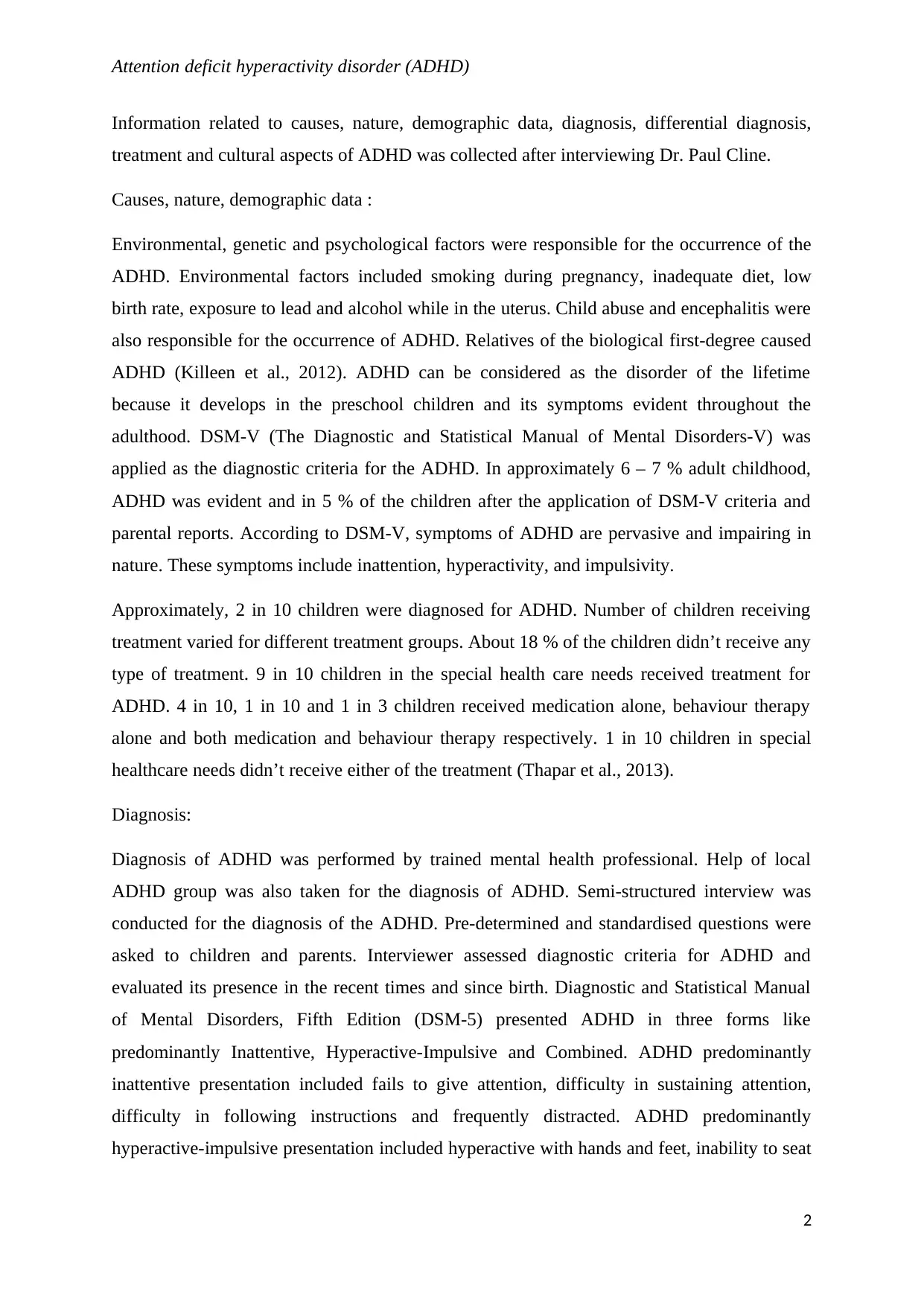
Attention deficit hyperactivity disorder (ADHD)
Information related to causes, nature, demographic data, diagnosis, differential diagnosis,
treatment and cultural aspects of ADHD was collected after interviewing Dr. Paul Cline.
Causes, nature, demographic data :
Environmental, genetic and psychological factors were responsible for the occurrence of the
ADHD. Environmental factors included smoking during pregnancy, inadequate diet, low
birth rate, exposure to lead and alcohol while in the uterus. Child abuse and encephalitis were
also responsible for the occurrence of ADHD. Relatives of the biological first-degree caused
ADHD (Killeen et al., 2012). ADHD can be considered as the disorder of the lifetime
because it develops in the preschool children and its symptoms evident throughout the
adulthood. DSM-V (The Diagnostic and Statistical Manual of Mental Disorders-V) was
applied as the diagnostic criteria for the ADHD. In approximately 6 – 7 % adult childhood,
ADHD was evident and in 5 % of the children after the application of DSM-V criteria and
parental reports. According to DSM-V, symptoms of ADHD are pervasive and impairing in
nature. These symptoms include inattention, hyperactivity, and impulsivity.
Approximately, 2 in 10 children were diagnosed for ADHD. Number of children receiving
treatment varied for different treatment groups. About 18 % of the children didn’t receive any
type of treatment. 9 in 10 children in the special health care needs received treatment for
ADHD. 4 in 10, 1 in 10 and 1 in 3 children received medication alone, behaviour therapy
alone and both medication and behaviour therapy respectively. 1 in 10 children in special
healthcare needs didn’t receive either of the treatment (Thapar et al., 2013).
Diagnosis:
Diagnosis of ADHD was performed by trained mental health professional. Help of local
ADHD group was also taken for the diagnosis of ADHD. Semi-structured interview was
conducted for the diagnosis of the ADHD. Pre-determined and standardised questions were
asked to children and parents. Interviewer assessed diagnostic criteria for ADHD and
evaluated its presence in the recent times and since birth. Diagnostic and Statistical Manual
of Mental Disorders, Fifth Edition (DSM-5) presented ADHD in three forms like
predominantly Inattentive, Hyperactive-Impulsive and Combined. ADHD predominantly
inattentive presentation included fails to give attention, difficulty in sustaining attention,
difficulty in following instructions and frequently distracted. ADHD predominantly
hyperactive-impulsive presentation included hyperactive with hands and feet, inability to seat
2
Information related to causes, nature, demographic data, diagnosis, differential diagnosis,
treatment and cultural aspects of ADHD was collected after interviewing Dr. Paul Cline.
Causes, nature, demographic data :
Environmental, genetic and psychological factors were responsible for the occurrence of the
ADHD. Environmental factors included smoking during pregnancy, inadequate diet, low
birth rate, exposure to lead and alcohol while in the uterus. Child abuse and encephalitis were
also responsible for the occurrence of ADHD. Relatives of the biological first-degree caused
ADHD (Killeen et al., 2012). ADHD can be considered as the disorder of the lifetime
because it develops in the preschool children and its symptoms evident throughout the
adulthood. DSM-V (The Diagnostic and Statistical Manual of Mental Disorders-V) was
applied as the diagnostic criteria for the ADHD. In approximately 6 – 7 % adult childhood,
ADHD was evident and in 5 % of the children after the application of DSM-V criteria and
parental reports. According to DSM-V, symptoms of ADHD are pervasive and impairing in
nature. These symptoms include inattention, hyperactivity, and impulsivity.
Approximately, 2 in 10 children were diagnosed for ADHD. Number of children receiving
treatment varied for different treatment groups. About 18 % of the children didn’t receive any
type of treatment. 9 in 10 children in the special health care needs received treatment for
ADHD. 4 in 10, 1 in 10 and 1 in 3 children received medication alone, behaviour therapy
alone and both medication and behaviour therapy respectively. 1 in 10 children in special
healthcare needs didn’t receive either of the treatment (Thapar et al., 2013).
Diagnosis:
Diagnosis of ADHD was performed by trained mental health professional. Help of local
ADHD group was also taken for the diagnosis of ADHD. Semi-structured interview was
conducted for the diagnosis of the ADHD. Pre-determined and standardised questions were
asked to children and parents. Interviewer assessed diagnostic criteria for ADHD and
evaluated its presence in the recent times and since birth. Diagnostic and Statistical Manual
of Mental Disorders, Fifth Edition (DSM-5) presented ADHD in three forms like
predominantly Inattentive, Hyperactive-Impulsive and Combined. ADHD predominantly
inattentive presentation included fails to give attention, difficulty in sustaining attention,
difficulty in following instructions and frequently distracted. ADHD predominantly
hyperactive-impulsive presentation included hyperactive with hands and feet, inability to seat
2

Attention deficit hyperactivity disorder (ADHD)
properly, runs and climb excessively, inability to perform activities quietly, excessive talking,
difficulty in waiting and taking turns and interrupting others (Batstra et al., 2014).
Psychological, neuropsychological or learning disabilities testing were performed in children.
These testing didn’t diagnose ADHD directly, however provided information about pattern of
ADHD. Medical testing like thyroid problems and seizure disorders were performed because
these conditions can cause symptoms similar to the ADHD (Kieling and Rohde, 2012).
Treatment:
Primarily psychoeducation and behavioural treatment were provided to reduce symptoms of
ADHD. ADHD disorder was discussed with the children and their parents which helped to
cope with the disorder. Reward system was implemented to reduce symptoms of the children.
Education and training was provided to the parents to understand problems of their children
and to provide appropriate solution. Parents were educated to improve positive
communication with the children to strengthen their relationship. Parents were instructed to
withhold the unwanted behaviour. Play therapy and talk therapy was also provided to the
children. In play therapy, children were asked to express their feelings and experiences
through play. In talk therapy, verbal communication was used to treat mental and emotional
disorder. However, based on the severity of the disease, medication treatment was also
provided. It was observed that combination of symptomatic and medication treatment proved
more efficacious. Treatment was provided based on the age of the children (Austerman,
2015).
In age group 4 – 5 years, psychoeducation and behavioural therapy was given sequentially.
Evidence based method was applied for the psychoeducation and behavioural therapy. In
case, significant improvement was not observed in these children, ADHD medications like
methylphenidate, dexamfetamine, lisdexamfetamine, atomoxetine, and guanfacine were
administered. In age group children 6 – 11 yrs, both behavioural therapy and medication were
given in combination. Appropriate school environment like proper classroom adaptation and
test modifications were provided to the children. It helped the children to feel more
comfortable. Behavioural plan and special social education was provided to the children. For,
adolescents in age group (12 – 18 yrs) first preference was given to the ADHD medications.
In few children, behavioural therapy was also provided. Preference was also given to provide
combined treatment of behavioural therapy and medication treatment (Faraone et al. 2015).
3
properly, runs and climb excessively, inability to perform activities quietly, excessive talking,
difficulty in waiting and taking turns and interrupting others (Batstra et al., 2014).
Psychological, neuropsychological or learning disabilities testing were performed in children.
These testing didn’t diagnose ADHD directly, however provided information about pattern of
ADHD. Medical testing like thyroid problems and seizure disorders were performed because
these conditions can cause symptoms similar to the ADHD (Kieling and Rohde, 2012).
Treatment:
Primarily psychoeducation and behavioural treatment were provided to reduce symptoms of
ADHD. ADHD disorder was discussed with the children and their parents which helped to
cope with the disorder. Reward system was implemented to reduce symptoms of the children.
Education and training was provided to the parents to understand problems of their children
and to provide appropriate solution. Parents were educated to improve positive
communication with the children to strengthen their relationship. Parents were instructed to
withhold the unwanted behaviour. Play therapy and talk therapy was also provided to the
children. In play therapy, children were asked to express their feelings and experiences
through play. In talk therapy, verbal communication was used to treat mental and emotional
disorder. However, based on the severity of the disease, medication treatment was also
provided. It was observed that combination of symptomatic and medication treatment proved
more efficacious. Treatment was provided based on the age of the children (Austerman,
2015).
In age group 4 – 5 years, psychoeducation and behavioural therapy was given sequentially.
Evidence based method was applied for the psychoeducation and behavioural therapy. In
case, significant improvement was not observed in these children, ADHD medications like
methylphenidate, dexamfetamine, lisdexamfetamine, atomoxetine, and guanfacine were
administered. In age group children 6 – 11 yrs, both behavioural therapy and medication were
given in combination. Appropriate school environment like proper classroom adaptation and
test modifications were provided to the children. It helped the children to feel more
comfortable. Behavioural plan and special social education was provided to the children. For,
adolescents in age group (12 – 18 yrs) first preference was given to the ADHD medications.
In few children, behavioural therapy was also provided. Preference was also given to provide
combined treatment of behavioural therapy and medication treatment (Faraone et al. 2015).
3
⊘ This is a preview!⊘
Do you want full access?
Subscribe today to unlock all pages.

Trusted by 1+ million students worldwide
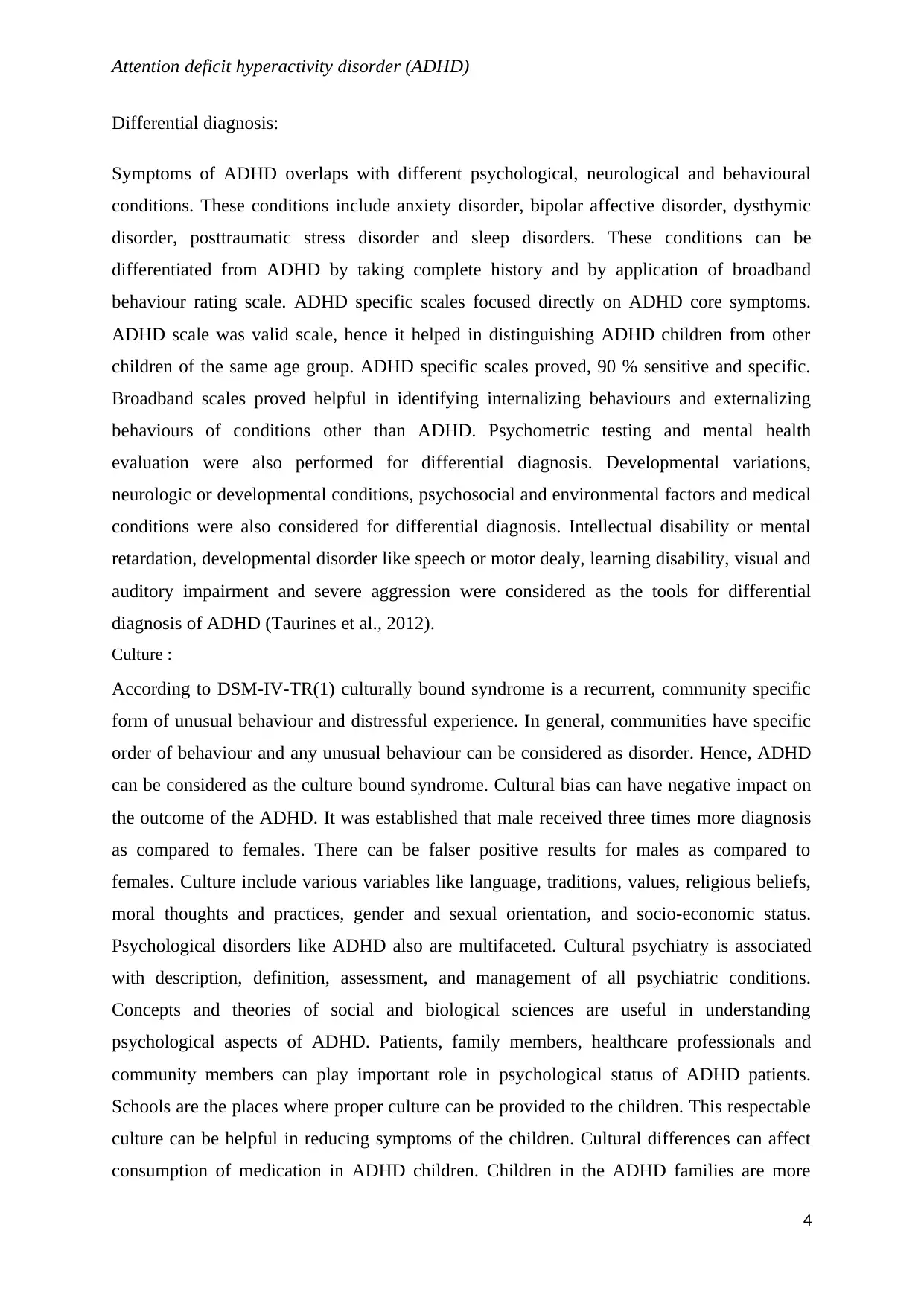
Attention deficit hyperactivity disorder (ADHD)
Differential diagnosis:
Symptoms of ADHD overlaps with different psychological, neurological and behavioural
conditions. These conditions include anxiety disorder, bipolar affective disorder, dysthymic
disorder, posttraumatic stress disorder and sleep disorders. These conditions can be
differentiated from ADHD by taking complete history and by application of broadband
behaviour rating scale. ADHD specific scales focused directly on ADHD core symptoms.
ADHD scale was valid scale, hence it helped in distinguishing ADHD children from other
children of the same age group. ADHD specific scales proved, 90 % sensitive and specific.
Broadband scales proved helpful in identifying internalizing behaviours and externalizing
behaviours of conditions other than ADHD. Psychometric testing and mental health
evaluation were also performed for differential diagnosis. Developmental variations,
neurologic or developmental conditions, psychosocial and environmental factors and medical
conditions were also considered for differential diagnosis. Intellectual disability or mental
retardation, developmental disorder like speech or motor dealy, learning disability, visual and
auditory impairment and severe aggression were considered as the tools for differential
diagnosis of ADHD (Taurines et al., 2012).
Culture :
According to DSM-IV-TR(1) culturally bound syndrome is a recurrent, community specific
form of unusual behaviour and distressful experience. In general, communities have specific
order of behaviour and any unusual behaviour can be considered as disorder. Hence, ADHD
can be considered as the culture bound syndrome. Cultural bias can have negative impact on
the outcome of the ADHD. It was established that male received three times more diagnosis
as compared to females. There can be falser positive results for males as compared to
females. Culture include various variables like language, traditions, values, religious beliefs,
moral thoughts and practices, gender and sexual orientation, and socio-economic status.
Psychological disorders like ADHD also are multifaceted. Cultural psychiatry is associated
with description, definition, assessment, and management of all psychiatric conditions.
Concepts and theories of social and biological sciences are useful in understanding
psychological aspects of ADHD. Patients, family members, healthcare professionals and
community members can play important role in psychological status of ADHD patients.
Schools are the places where proper culture can be provided to the children. This respectable
culture can be helpful in reducing symptoms of the children. Cultural differences can affect
consumption of medication in ADHD children. Children in the ADHD families are more
4
Differential diagnosis:
Symptoms of ADHD overlaps with different psychological, neurological and behavioural
conditions. These conditions include anxiety disorder, bipolar affective disorder, dysthymic
disorder, posttraumatic stress disorder and sleep disorders. These conditions can be
differentiated from ADHD by taking complete history and by application of broadband
behaviour rating scale. ADHD specific scales focused directly on ADHD core symptoms.
ADHD scale was valid scale, hence it helped in distinguishing ADHD children from other
children of the same age group. ADHD specific scales proved, 90 % sensitive and specific.
Broadband scales proved helpful in identifying internalizing behaviours and externalizing
behaviours of conditions other than ADHD. Psychometric testing and mental health
evaluation were also performed for differential diagnosis. Developmental variations,
neurologic or developmental conditions, psychosocial and environmental factors and medical
conditions were also considered for differential diagnosis. Intellectual disability or mental
retardation, developmental disorder like speech or motor dealy, learning disability, visual and
auditory impairment and severe aggression were considered as the tools for differential
diagnosis of ADHD (Taurines et al., 2012).
Culture :
According to DSM-IV-TR(1) culturally bound syndrome is a recurrent, community specific
form of unusual behaviour and distressful experience. In general, communities have specific
order of behaviour and any unusual behaviour can be considered as disorder. Hence, ADHD
can be considered as the culture bound syndrome. Cultural bias can have negative impact on
the outcome of the ADHD. It was established that male received three times more diagnosis
as compared to females. There can be falser positive results for males as compared to
females. Culture include various variables like language, traditions, values, religious beliefs,
moral thoughts and practices, gender and sexual orientation, and socio-economic status.
Psychological disorders like ADHD also are multifaceted. Cultural psychiatry is associated
with description, definition, assessment, and management of all psychiatric conditions.
Concepts and theories of social and biological sciences are useful in understanding
psychological aspects of ADHD. Patients, family members, healthcare professionals and
community members can play important role in psychological status of ADHD patients.
Schools are the places where proper culture can be provided to the children. This respectable
culture can be helpful in reducing symptoms of the children. Cultural differences can affect
consumption of medication in ADHD children. Children in the ADHD families are more
4
Paraphrase This Document
Need a fresh take? Get an instant paraphrase of this document with our AI Paraphraser
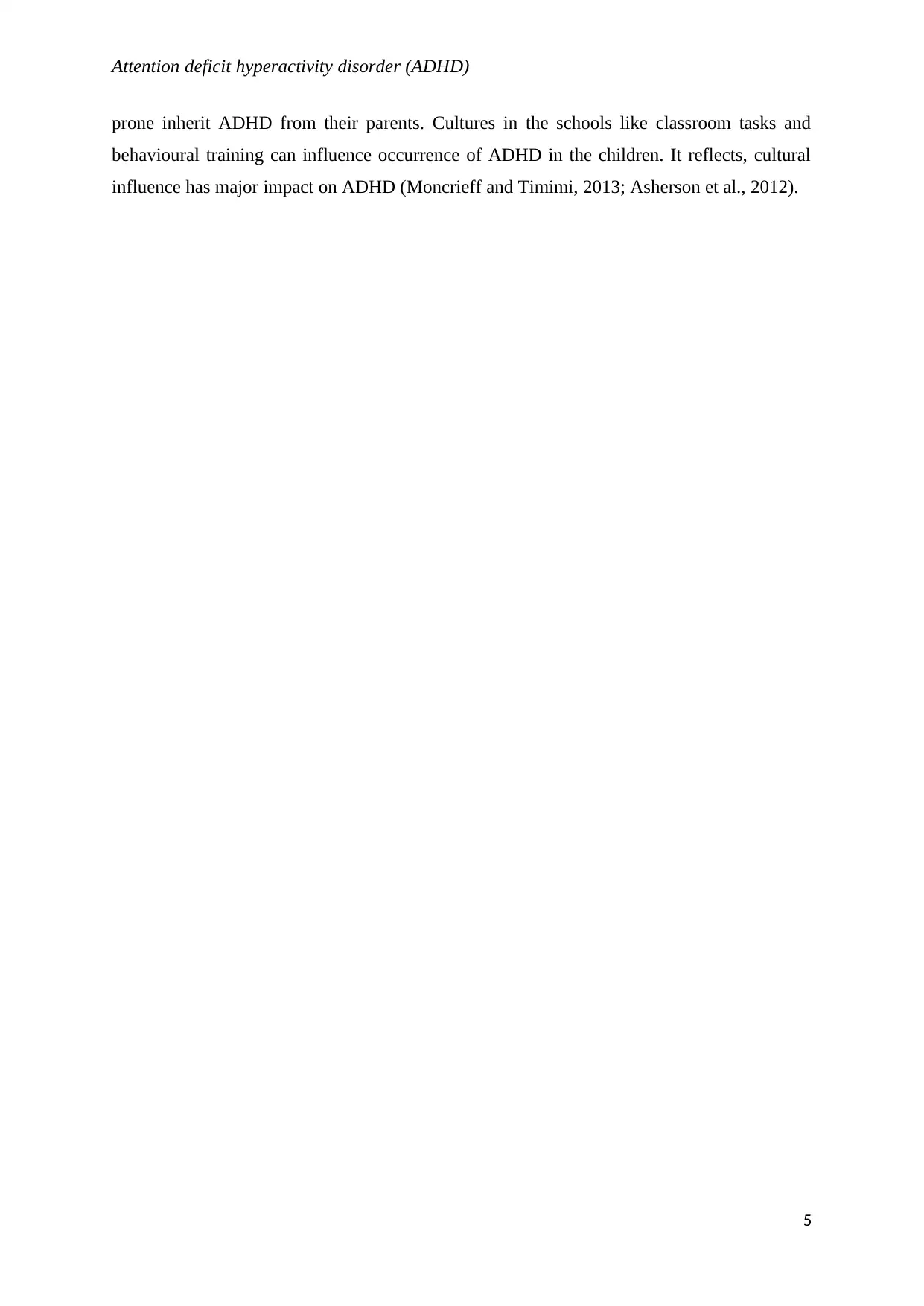
Attention deficit hyperactivity disorder (ADHD)
prone inherit ADHD from their parents. Cultures in the schools like classroom tasks and
behavioural training can influence occurrence of ADHD in the children. It reflects, cultural
influence has major impact on ADHD (Moncrieff and Timimi, 2013; Asherson et al., 2012).
5
prone inherit ADHD from their parents. Cultures in the schools like classroom tasks and
behavioural training can influence occurrence of ADHD in the children. It reflects, cultural
influence has major impact on ADHD (Moncrieff and Timimi, 2013; Asherson et al., 2012).
5
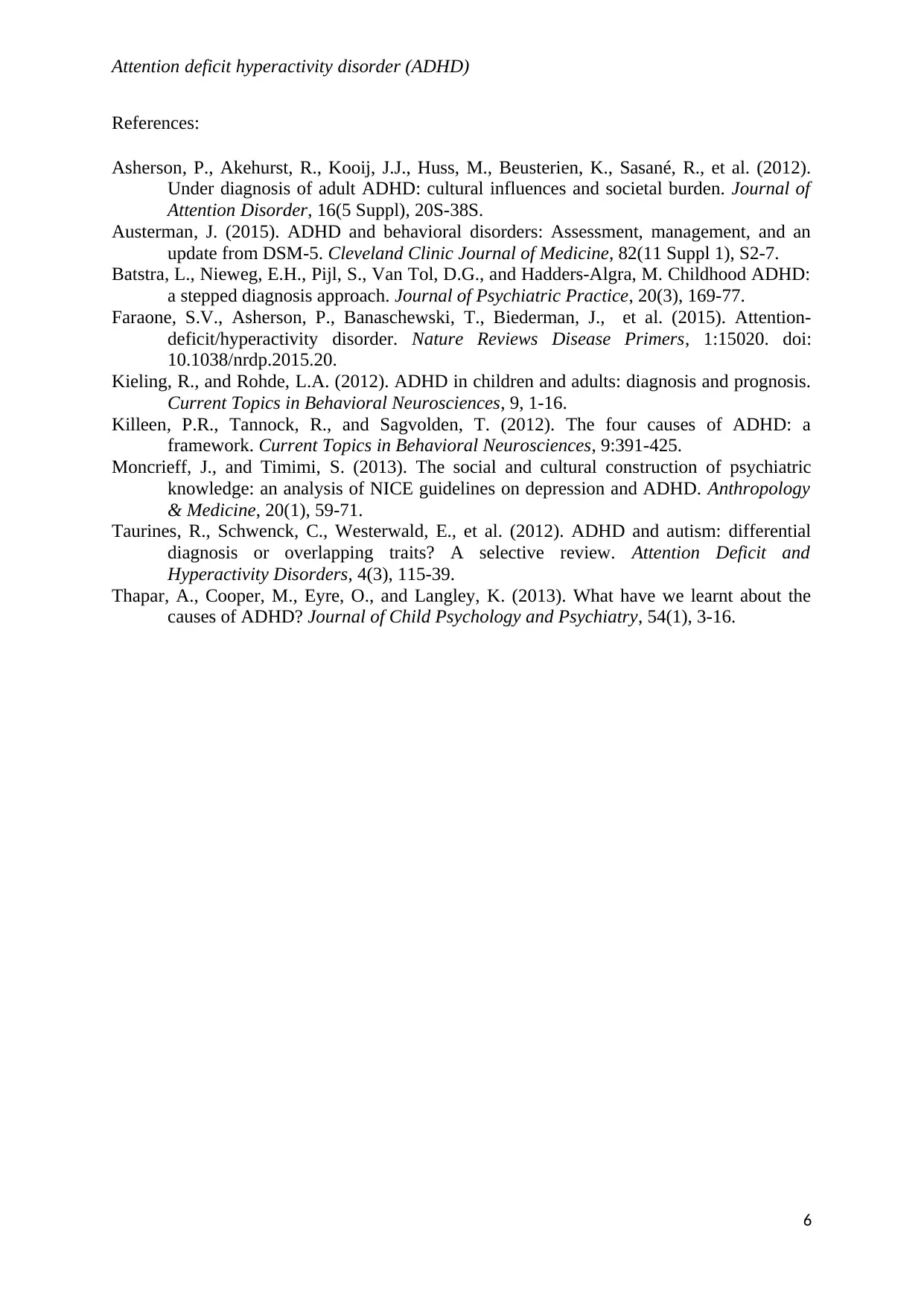
Attention deficit hyperactivity disorder (ADHD)
References:
Asherson, P., Akehurst, R., Kooij, J.J., Huss, M., Beusterien, K., Sasané, R., et al. (2012).
Under diagnosis of adult ADHD: cultural influences and societal burden. Journal of
Attention Disorder, 16(5 Suppl), 20S-38S.
Austerman, J. (2015). ADHD and behavioral disorders: Assessment, management, and an
update from DSM-5. Cleveland Clinic Journal of Medicine, 82(11 Suppl 1), S2-7.
Batstra, L., Nieweg, E.H., Pijl, S., Van Tol, D.G., and Hadders-Algra, M. Childhood ADHD:
a stepped diagnosis approach. Journal of Psychiatric Practice, 20(3), 169-77.
Faraone, S.V., Asherson, P., Banaschewski, T., Biederman, J., et al. (2015). Attention-
deficit/hyperactivity disorder. Nature Reviews Disease Primers, 1:15020. doi:
10.1038/nrdp.2015.20.
Kieling, R., and Rohde, L.A. (2012). ADHD in children and adults: diagnosis and prognosis.
Current Topics in Behavioral Neurosciences, 9, 1-16.
Killeen, P.R., Tannock, R., and Sagvolden, T. (2012). The four causes of ADHD: a
framework. Current Topics in Behavioral Neurosciences, 9:391-425.
Moncrieff, J., and Timimi, S. (2013). The social and cultural construction of psychiatric
knowledge: an analysis of NICE guidelines on depression and ADHD. Anthropology
& Medicine, 20(1), 59-71.
Taurines, R., Schwenck, C., Westerwald, E., et al. (2012). ADHD and autism: differential
diagnosis or overlapping traits? A selective review. Attention Deficit and
Hyperactivity Disorders, 4(3), 115-39.
Thapar, A., Cooper, M., Eyre, O., and Langley, K. (2013). What have we learnt about the
causes of ADHD? Journal of Child Psychology and Psychiatry, 54(1), 3-16.
6
References:
Asherson, P., Akehurst, R., Kooij, J.J., Huss, M., Beusterien, K., Sasané, R., et al. (2012).
Under diagnosis of adult ADHD: cultural influences and societal burden. Journal of
Attention Disorder, 16(5 Suppl), 20S-38S.
Austerman, J. (2015). ADHD and behavioral disorders: Assessment, management, and an
update from DSM-5. Cleveland Clinic Journal of Medicine, 82(11 Suppl 1), S2-7.
Batstra, L., Nieweg, E.H., Pijl, S., Van Tol, D.G., and Hadders-Algra, M. Childhood ADHD:
a stepped diagnosis approach. Journal of Psychiatric Practice, 20(3), 169-77.
Faraone, S.V., Asherson, P., Banaschewski, T., Biederman, J., et al. (2015). Attention-
deficit/hyperactivity disorder. Nature Reviews Disease Primers, 1:15020. doi:
10.1038/nrdp.2015.20.
Kieling, R., and Rohde, L.A. (2012). ADHD in children and adults: diagnosis and prognosis.
Current Topics in Behavioral Neurosciences, 9, 1-16.
Killeen, P.R., Tannock, R., and Sagvolden, T. (2012). The four causes of ADHD: a
framework. Current Topics in Behavioral Neurosciences, 9:391-425.
Moncrieff, J., and Timimi, S. (2013). The social and cultural construction of psychiatric
knowledge: an analysis of NICE guidelines on depression and ADHD. Anthropology
& Medicine, 20(1), 59-71.
Taurines, R., Schwenck, C., Westerwald, E., et al. (2012). ADHD and autism: differential
diagnosis or overlapping traits? A selective review. Attention Deficit and
Hyperactivity Disorders, 4(3), 115-39.
Thapar, A., Cooper, M., Eyre, O., and Langley, K. (2013). What have we learnt about the
causes of ADHD? Journal of Child Psychology and Psychiatry, 54(1), 3-16.
6
⊘ This is a preview!⊘
Do you want full access?
Subscribe today to unlock all pages.

Trusted by 1+ million students worldwide
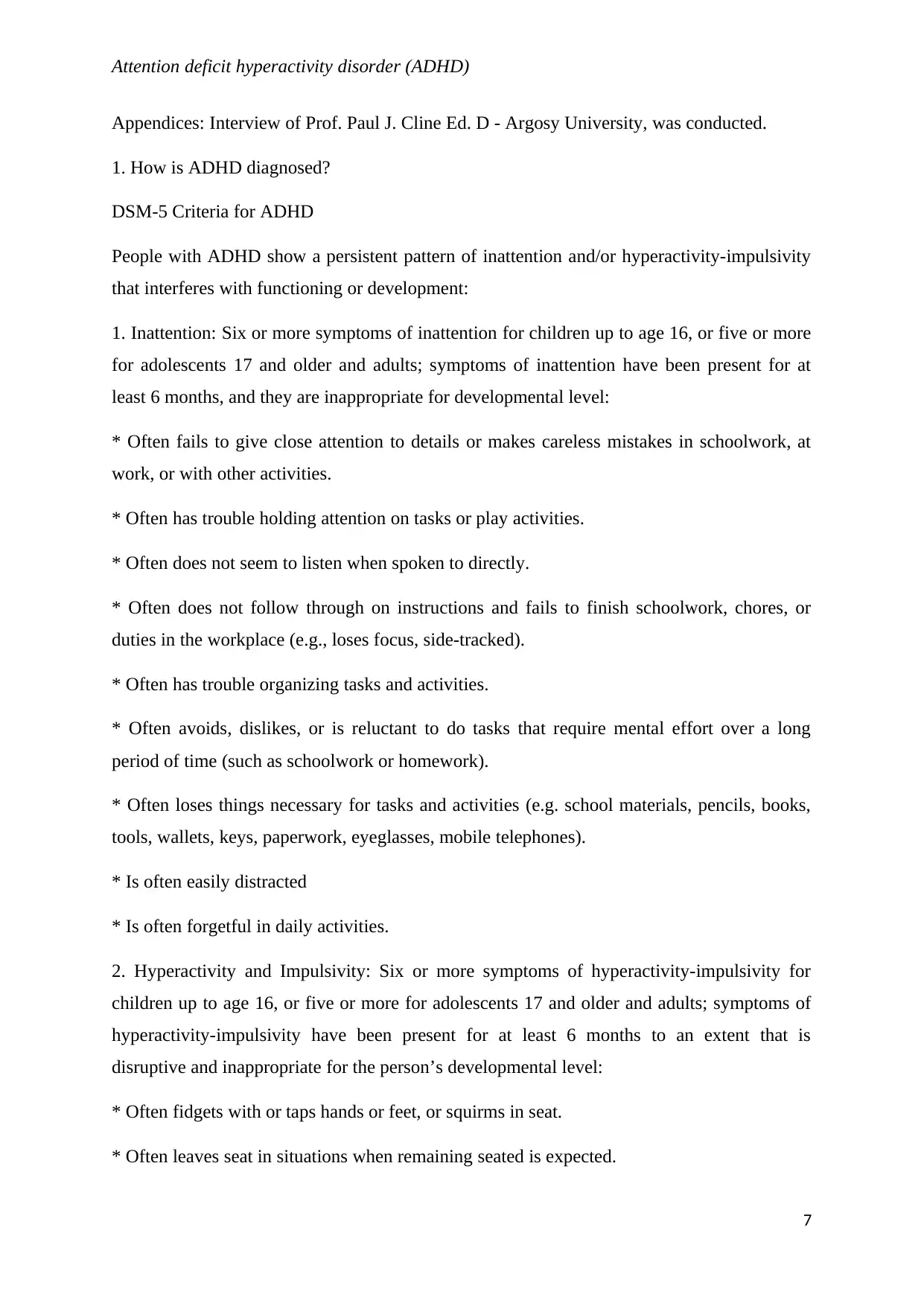
Attention deficit hyperactivity disorder (ADHD)
Appendices: Interview of Prof. Paul J. Cline Ed. D - Argosy University, was conducted.
1. How is ADHD diagnosed?
DSM-5 Criteria for ADHD
People with ADHD show a persistent pattern of inattention and/or hyperactivity-impulsivity
that interferes with functioning or development:
1. Inattention: Six or more symptoms of inattention for children up to age 16, or five or more
for adolescents 17 and older and adults; symptoms of inattention have been present for at
least 6 months, and they are inappropriate for developmental level:
* Often fails to give close attention to details or makes careless mistakes in schoolwork, at
work, or with other activities.
* Often has trouble holding attention on tasks or play activities.
* Often does not seem to listen when spoken to directly.
* Often does not follow through on instructions and fails to finish schoolwork, chores, or
duties in the workplace (e.g., loses focus, side-tracked).
* Often has trouble organizing tasks and activities.
* Often avoids, dislikes, or is reluctant to do tasks that require mental effort over a long
period of time (such as schoolwork or homework).
* Often loses things necessary for tasks and activities (e.g. school materials, pencils, books,
tools, wallets, keys, paperwork, eyeglasses, mobile telephones).
* Is often easily distracted
* Is often forgetful in daily activities.
2. Hyperactivity and Impulsivity: Six or more symptoms of hyperactivity-impulsivity for
children up to age 16, or five or more for adolescents 17 and older and adults; symptoms of
hyperactivity-impulsivity have been present for at least 6 months to an extent that is
disruptive and inappropriate for the person’s developmental level:
* Often fidgets with or taps hands or feet, or squirms in seat.
* Often leaves seat in situations when remaining seated is expected.
7
Appendices: Interview of Prof. Paul J. Cline Ed. D - Argosy University, was conducted.
1. How is ADHD diagnosed?
DSM-5 Criteria for ADHD
People with ADHD show a persistent pattern of inattention and/or hyperactivity-impulsivity
that interferes with functioning or development:
1. Inattention: Six or more symptoms of inattention for children up to age 16, or five or more
for adolescents 17 and older and adults; symptoms of inattention have been present for at
least 6 months, and they are inappropriate for developmental level:
* Often fails to give close attention to details or makes careless mistakes in schoolwork, at
work, or with other activities.
* Often has trouble holding attention on tasks or play activities.
* Often does not seem to listen when spoken to directly.
* Often does not follow through on instructions and fails to finish schoolwork, chores, or
duties in the workplace (e.g., loses focus, side-tracked).
* Often has trouble organizing tasks and activities.
* Often avoids, dislikes, or is reluctant to do tasks that require mental effort over a long
period of time (such as schoolwork or homework).
* Often loses things necessary for tasks and activities (e.g. school materials, pencils, books,
tools, wallets, keys, paperwork, eyeglasses, mobile telephones).
* Is often easily distracted
* Is often forgetful in daily activities.
2. Hyperactivity and Impulsivity: Six or more symptoms of hyperactivity-impulsivity for
children up to age 16, or five or more for adolescents 17 and older and adults; symptoms of
hyperactivity-impulsivity have been present for at least 6 months to an extent that is
disruptive and inappropriate for the person’s developmental level:
* Often fidgets with or taps hands or feet, or squirms in seat.
* Often leaves seat in situations when remaining seated is expected.
7
Paraphrase This Document
Need a fresh take? Get an instant paraphrase of this document with our AI Paraphraser
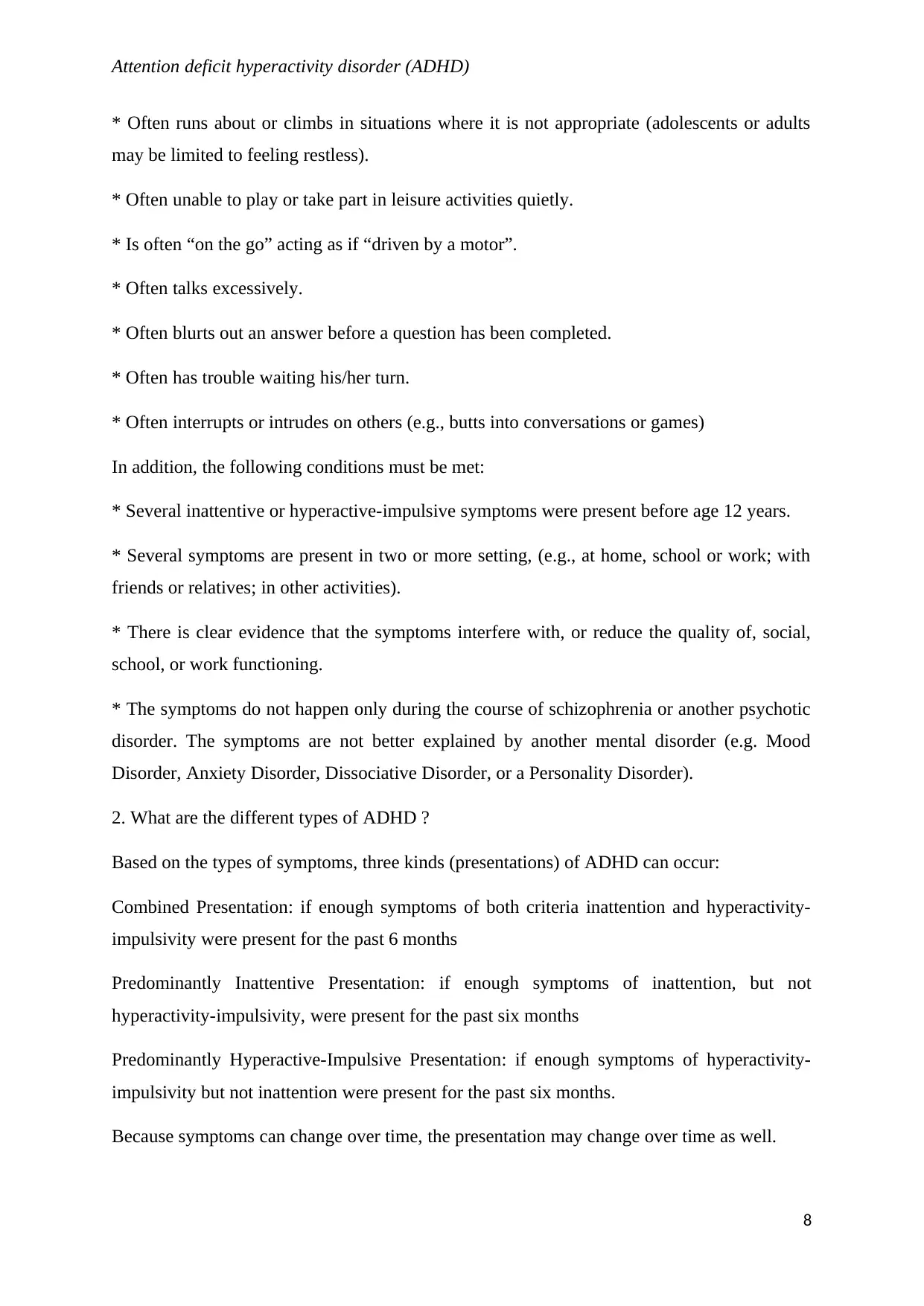
Attention deficit hyperactivity disorder (ADHD)
* Often runs about or climbs in situations where it is not appropriate (adolescents or adults
may be limited to feeling restless).
* Often unable to play or take part in leisure activities quietly.
* Is often “on the go” acting as if “driven by a motor”.
* Often talks excessively.
* Often blurts out an answer before a question has been completed.
* Often has trouble waiting his/her turn.
* Often interrupts or intrudes on others (e.g., butts into conversations or games)
In addition, the following conditions must be met:
* Several inattentive or hyperactive-impulsive symptoms were present before age 12 years.
* Several symptoms are present in two or more setting, (e.g., at home, school or work; with
friends or relatives; in other activities).
* There is clear evidence that the symptoms interfere with, or reduce the quality of, social,
school, or work functioning.
* The symptoms do not happen only during the course of schizophrenia or another psychotic
disorder. The symptoms are not better explained by another mental disorder (e.g. Mood
Disorder, Anxiety Disorder, Dissociative Disorder, or a Personality Disorder).
2. What are the different types of ADHD ?
Based on the types of symptoms, three kinds (presentations) of ADHD can occur:
Combined Presentation: if enough symptoms of both criteria inattention and hyperactivity-
impulsivity were present for the past 6 months
Predominantly Inattentive Presentation: if enough symptoms of inattention, but not
hyperactivity-impulsivity, were present for the past six months
Predominantly Hyperactive-Impulsive Presentation: if enough symptoms of hyperactivity-
impulsivity but not inattention were present for the past six months.
Because symptoms can change over time, the presentation may change over time as well.
8
* Often runs about or climbs in situations where it is not appropriate (adolescents or adults
may be limited to feeling restless).
* Often unable to play or take part in leisure activities quietly.
* Is often “on the go” acting as if “driven by a motor”.
* Often talks excessively.
* Often blurts out an answer before a question has been completed.
* Often has trouble waiting his/her turn.
* Often interrupts or intrudes on others (e.g., butts into conversations or games)
In addition, the following conditions must be met:
* Several inattentive or hyperactive-impulsive symptoms were present before age 12 years.
* Several symptoms are present in two or more setting, (e.g., at home, school or work; with
friends or relatives; in other activities).
* There is clear evidence that the symptoms interfere with, or reduce the quality of, social,
school, or work functioning.
* The symptoms do not happen only during the course of schizophrenia or another psychotic
disorder. The symptoms are not better explained by another mental disorder (e.g. Mood
Disorder, Anxiety Disorder, Dissociative Disorder, or a Personality Disorder).
2. What are the different types of ADHD ?
Based on the types of symptoms, three kinds (presentations) of ADHD can occur:
Combined Presentation: if enough symptoms of both criteria inattention and hyperactivity-
impulsivity were present for the past 6 months
Predominantly Inattentive Presentation: if enough symptoms of inattention, but not
hyperactivity-impulsivity, were present for the past six months
Predominantly Hyperactive-Impulsive Presentation: if enough symptoms of hyperactivity-
impulsivity but not inattention were present for the past six months.
Because symptoms can change over time, the presentation may change over time as well.
8
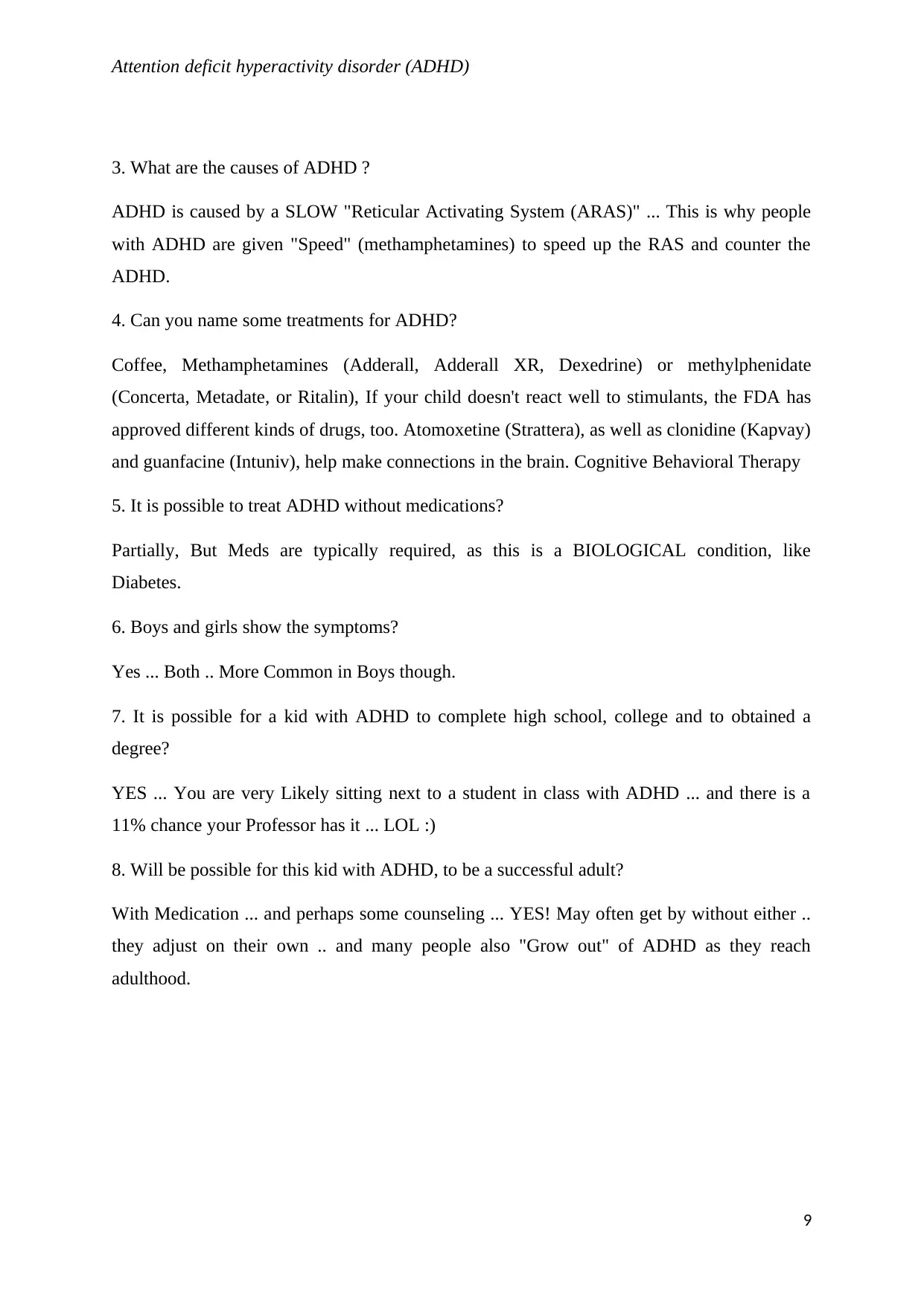
Attention deficit hyperactivity disorder (ADHD)
3. What are the causes of ADHD ?
ADHD is caused by a SLOW "Reticular Activating System (ARAS)" ... This is why people
with ADHD are given "Speed" (methamphetamines) to speed up the RAS and counter the
ADHD.
4. Can you name some treatments for ADHD?
Coffee, Methamphetamines (Adderall, Adderall XR, Dexedrine) or methylphenidate
(Concerta, Metadate, or Ritalin), If your child doesn't react well to stimulants, the FDA has
approved different kinds of drugs, too. Atomoxetine (Strattera), as well as clonidine (Kapvay)
and guanfacine (Intuniv), help make connections in the brain. Cognitive Behavioral Therapy
5. It is possible to treat ADHD without medications?
Partially, But Meds are typically required, as this is a BIOLOGICAL condition, like
Diabetes.
6. Boys and girls show the symptoms?
Yes ... Both .. More Common in Boys though.
7. It is possible for a kid with ADHD to complete high school, college and to obtained a
degree?
YES ... You are very Likely sitting next to a student in class with ADHD ... and there is a
11% chance your Professor has it ... LOL :)
8. Will be possible for this kid with ADHD, to be a successful adult?
With Medication ... and perhaps some counseling ... YES! May often get by without either ..
they adjust on their own .. and many people also "Grow out" of ADHD as they reach
adulthood.
9
3. What are the causes of ADHD ?
ADHD is caused by a SLOW "Reticular Activating System (ARAS)" ... This is why people
with ADHD are given "Speed" (methamphetamines) to speed up the RAS and counter the
ADHD.
4. Can you name some treatments for ADHD?
Coffee, Methamphetamines (Adderall, Adderall XR, Dexedrine) or methylphenidate
(Concerta, Metadate, or Ritalin), If your child doesn't react well to stimulants, the FDA has
approved different kinds of drugs, too. Atomoxetine (Strattera), as well as clonidine (Kapvay)
and guanfacine (Intuniv), help make connections in the brain. Cognitive Behavioral Therapy
5. It is possible to treat ADHD without medications?
Partially, But Meds are typically required, as this is a BIOLOGICAL condition, like
Diabetes.
6. Boys and girls show the symptoms?
Yes ... Both .. More Common in Boys though.
7. It is possible for a kid with ADHD to complete high school, college and to obtained a
degree?
YES ... You are very Likely sitting next to a student in class with ADHD ... and there is a
11% chance your Professor has it ... LOL :)
8. Will be possible for this kid with ADHD, to be a successful adult?
With Medication ... and perhaps some counseling ... YES! May often get by without either ..
they adjust on their own .. and many people also "Grow out" of ADHD as they reach
adulthood.
9
⊘ This is a preview!⊘
Do you want full access?
Subscribe today to unlock all pages.

Trusted by 1+ million students worldwide
1 out of 9
Related Documents
Your All-in-One AI-Powered Toolkit for Academic Success.
+13062052269
info@desklib.com
Available 24*7 on WhatsApp / Email
![[object Object]](/_next/static/media/star-bottom.7253800d.svg)
Unlock your academic potential
Copyright © 2020–2025 A2Z Services. All Rights Reserved. Developed and managed by ZUCOL.





